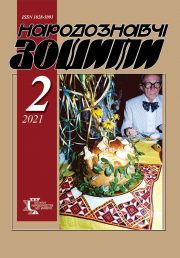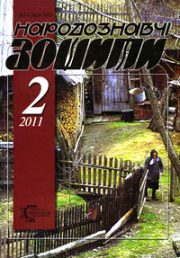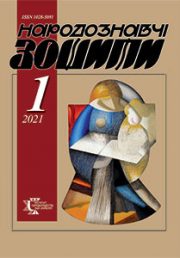The Ethnology Notebooks. 2021. № 5 (161), 1137—1149
UDK 392.34:37.018.1.03(477)
DOI https://doi.org/10.15407/nz2021.05.1137
THROWING A MILK TOOTH ON THE ROOF IN THE RITES OF THE PEOPLES OF THE WORLD
RAKHNO Kostyantyn
- ORCID ID: https://orcid.org/0000-0002-0973-3919
- Doctor of Sciences in History,
- Leading Researcher of the National Museum
- of Ukrainian Pottery in Opishne,
- 102 Partyzanska Street, 38164, Opishne,
- Zinkiv District, Poltava Region, Ukraine
- Contacts: e-mail: krakhno@ukr.net
Abstract. The roof in the worldviews of different cultures is of great interest for ethnographers and folklorists. Its image is present in myths, legends, epics, fairy tales, ritual texts and more. The house was not only a material object, but also one of the key symbols of culture, so it was always in the center of attention of human experiences. Therefore, the study of its role in the rites of the life cycle is especially relevant. In those of them related to childhood, the roof was especially frequent in the rite of returning the tooth, which consisted of a certain ritual treatment of the baby tooth that fell out. Such a tooth was sent to a certain mythologized creature, mainly an animal, in order to «exchange» for another one. They did it by throwing it away. The target was often a mouse or other rodent, less often a bird, such as a crow or a magpie, endowed with the features of intermediaries between the worlds. A significant place in the rites was occupied by the exchange formula: «Take the old (bad) one and give me the new (good) one». All the details of the rite of return of the tooth were semantically significant and had much in common in distant peoples. It is the author’s goal to explore them. The object of this study is the ejection of a baby tooth in the rites of the peoples of the world, which had regional variations, and its subject is the role of the roof and its covering in these rites, which manifested itself in rites, ritual formulas and concomitant beliefs, with their ethnic and regional variations. The methodological basis of the study is the historical-comparative method in combination with the philosophical-anthropological approach and methods of hermeneutics.
The basis of this work is the descriptions of the rite of throwing a baby tooth on the roof of a house in the world, made in the 19th—20th centuries, which show their common and distinctive features, the role of roofing in modeling the future health of the child. The results of the study are that they shed light on the role of the roof in this area of childhood ethnography, the sacred significance attributed to it as the boundary between worlds and the habitat of mythologized rodents or birds to which a baby tooth was given. Various semiotic and symbolic aspects of the roof and related rituals, which were throwing the baby tooth to and over the roof, the meaning of roofing, become clear through ritual formulas and beliefs that built the future health of the baby, the emergence of healthy permanent teeth, arrival of welfare to the family.
Keywords: childhood ethnography, transition rites, house, roof, baby teeth, mythology.
Received 5.07.2021
REFERENCES
- Sartori, P. (1910). Custom and Tradition (Part 1). The Main Stages of Human Existence). Leipzig: Verlag von Wilhelm Heims [in German].
- Berezina, T.A. (1999). The Norwegians. In Childbirth in Customs and Ceremonies. Countries of the Foreign Europe (Pp. 438—447). Moscow: Nauka [in Russian].
- Shmygina, N.V. (1999). The Finns. In Childbirth in Customs and Ceremonies. Countries of the Foreign Europe (Pp. 460—476). Moscow: Nauka [in Russian].
- Bronner, S. (2011). Explaining Traditions: Folk Behavior in Modern Culture. Lexington: University Press of Kentucky.
- Frazer, J.G. (1936). The Golden Bough: Afternath. A Supplement to the Golden Bough. London and Basingtoke: The MacMillan Press Ltd.
- Makilam (2007). Symbols and Magic in the Arts of Kabyle Women. New York: Peter Lang Publishing, Inc.
- Svanberg, I. (1987). The Folklore of Teeth Among Turkic and Adjacent Peoples. In Central Asiatic Journal, 1/2 (Vol. 31, pp. 111—137).
- Tanner, J. (1968). The Teeth in Folklore. In Western Folklore, 2 (Vol. 27, pp. 97—105).
- Reshyna, M.I. (1999). Nations of Belgium and the Netherlands. In Childbirth in Customs and Ceremonies. Countries of the Foreign Europe (Pp. 342—384). Moscow: Nauka [in Russian].
- Kolberg, O. (1979). All Works. Red Rus (Vol. 57, part II, book 2). Wroclaw and Poznan: Polish Music Publishing House; People’s Publishing Cooperative Society [in Polish].
- Kaindl, R.F. (1898). Songs, Nursery Rhymes, Counting-Out Rhymes, Games, Secret Languages and Various Medley from the Children’s World. In Journal of the Ethnology Society, 8, 314—322 [in German].
- Chubynsky, P.P. (1872). Proceedings of the Ethnographic and Statistical Expedition to the West-Russian Region, Equipped by the Imperial Russian Geographical Society (Vol. 1). Beliefs and Superstitions. Riddles and Proverbs. Witchcraft). St. Petersburg: V. Bezobrazov’s typography [in Russian].
- Nowosielski, A. (1857). Ukrainian People (Vol. 2). Vilnius: printed by Teofil Glucksberg, bookseller and printer of the Vilnius Scientific District [in Polish].
- Schnaider, J. (1907). People from Peczenizhyn. An Ethnographical Sketch. In People (Part II, vol. XIII, pp. 21—33, 98—117, 202—215 [in Polish].
- Kovalenko, G., & Manzhura, I. (1891). Towards Folk Medicine of the Little Russians. In Ethnographic Review, 4, 169—183 [in Russian].
- Vasylenko, M.G., Shevchuk, T.M., & Vasylenko, M.G.(Eds.).(1991). You, Stars…: Ukrainian Folk Magic Poetry (Spells). Kyiv: Molod [in Ukrainian].
- Yefimenko, P. (1874, january-march). A Collection of Little Russian Spells. Readings in the Imperial Society of the Russian History and Antiquities (Book 1, pp. 1—70). Moscow: University Printing House [in Russian].
- Hovorka, O., & Kronfeld, A. (1909). Comparative Folk Medicine: a Description of Folk Medical Customs and Habits, Views and Healing Faktors, of Superstitions and Magical Medicine (Vol. 2). Stuttgart: Strecker & Schröder’s Publishing House [in German].
- Kharlamov, M. (1901). Superstitions, Beliefs, Omens, Spells, Collected in the City of Yeysk. Collection of Materials for the Description of Localities and Tribes of the Caucasus (Issue 29, chapter 3, pp. 1—48). Tiflis: printing houses of the Office of the Commander-in-Chief of the Civil Unit in the Caucasus and K. Kozlovsky [in Russian].
- Weissenberg, S. (1903). Childish Joy and Suffering among the Southern Russian Jews. Globus. Illustrated Journal for Geography and Ethnology (Vol. LXXXIII, pp. 315—320) [in German].
- Frazer, J.G. (1920). The Golden Bough: A Study in Magic and Religion. The Magic Art and the Evolution of Kings (Vol. I, part I). London: MacMillan and Co., Limited.
- Kashuba, M.S., & Martynova, M.Yu. (1999). Southern Slavic Nations. In Childbirth in Customs and Ceremonies. Countries of the Foreign Europe (Pp. 59—97). Moscow: Nauka [in Russian].
- Markova, L.V. (1999). The Bulgarians. In Childbirth in Customs and Ceremonies. Countries of the Foreign Europe (Pp. 98—125). Moscow: Nauka [in Russian].
- Marinov, D. (1981). Selected Works in two volumes. Folk Faith and Religious Folk Customs (Vol. 1). Sofia: Nauka i izkustvo [in Bulgarian].
- Trefilova, O.V. (2004). Ethnolinguistic Materials from the Village of Stakevci, near the City of Belogradchik (Northwestern Bulgaria). Studies in Slavic Dialectology. Terminological Lexis of the Material and Spiritual Culture of the Balkan Slavs (Issue 10, pp. 354—398). Moscow: Institute of Slavic Studies of the RAS [in Russian].
- Mladenov, S., Kodov, Kh., & Vakarelski, Kh. (1935). Everyday Life and Language of the Thracian and Asia Minor Bulgarians. Everyday Life (Part 1). Sofia: Thracian Scientific Institute [in Bulgarian].
- Genchev, S. (1974). Family Customs and Rites. Dobrudzha: Ethnographical, Folkloristic and Linguistic Studies (Pp. 265—300). Sofia: publishing house of the Bulgarian Academy of Sciences[in Bulgarian].
- Havryliuk, N.K. (1987). The all-Soviet One and the Ethnic Specific One in the Modern Ceremonies of the Bulgarian Population of the Ukraine. Solidarity of Peoples — Solidarity of Cultures: Ukrainian-Bulgarian Cultural Ties: History and Modernity. For the 10th International Congress of Slavicists (Pp. 102—126). Kyiv: Naukova dumka [in Russian].
- Strezeva, N. (1995). Festal and Ceremonial System of the Population from the village of Glavani в Bessarabia. The Bulgarians in the Northern Black Sea Region. Studies and Materials (Vol. 4, pp. 363—375). Veliko Tirnovo: Asta [in Bulgarian].
- Kuroglo, S.S. (1980). Family Ceremonies of the Gagauz in the 19th — Early 20th Century. Chisinau: Stiinta [in Moldovan].
- Karadzic,V.S. (1849). Serbian Folk Proverbs and Other Different Usual Sayings. Bec: printing house of the Armenian Monastery [in Serbian].
- Schneeweis, E. (1961). Serbo-Croatian Ethnography. Folk Beliefs and Folk Customs (Part 1). Berlin: Walter de Gruyter GmbH & Co [in German].
- Abbott, G.F. (1903). Macedonian Folklore. Cambridge: University Press.
- Kozhanovsky, A.N. (1999). Nations of Spain. In Childbirth in Customs and Ceremonies. Countries of the Foreign Europe (Pp. 302—326). Moscow: Nauka [in Russian].
- Popova, Ye.V. (1998). Family Customs and Rites of the Besermyans (Early 19th — the 1990s.). Izhevsk: Udmurtian Institute of History, Language and Literature of the Ural Branch of the RAS [in Russian].
- Chernykh, A.V. (2003). Perm Gypsies: Sketches of the Ethnography of a Gipsy Camp (Based on the Materials of the Studies of the Gypsies in the Chapayevskiy Micro-Districh in the City of Perm). Perm: Perm State University [in Russian].
- Chochiyev, G.V. (2007). Information of the Turkish Ethnographer Y. Kalafat on the Folk Beliefs of the Sarikamiş Ossetians. Proceedings of the North-Ossetian Institute of Humanitarian and Social Studies, 1 (40), 193—200 [in Russian].
- Akiyeva, P. (2014). Birth, Wedding, Death. Historical and Ethnographical Archetypes of the Ingushes. Saint-Petersburg: Aleph-press [in Russian].
- Kalmykov, I.Kh., Kereitov, R.Kh., & Sikaliev, A.I. (1988). Nogay People. Cherkessk: Stavropol book publishing house, Karachai-Cirkassian department [in Russian].
- Sferbekov, R.I. (2019). Modern Ceremonies, Connected with Childbirth, among the Dagestan Townspeople: Syncretism of Islam, Traditional and New Customs. Islam and Islam Studies in Modern Russia: Collections of Reports of the All-Russian Islam Studies Forum (city of Makhachkala, September 27—28, 2019) (Pp. 192—201). Makhachkala: Aleph [in Russian].
- Kurbanov, M.-Z.Yu. (2006). The Population of Syurga. The 19th — Early 20th Centuries: Historical and Ethnographical Study. Makhachkala: Institute of History, Archaeology and Ethnography of the Dagestan Scientific Centre of the RAS [in Russian].
- Chesnov, Ya.V. (1991). Male and Female Principles in Childbirth According to Beliefs of the Abkhazian and Adyghe Peoples. Ethnic Stereotypes of the Male and Female Behaviour (Pp. 132—158). Saint-Petersburg: Nauka [in Russian].
- Kunizheva, L.Z. (1989). Family Ceremonies. The Abazins: Historical and Ethnographical Sketch (Pp. 164—181). Cherkessk: Stavropol book publishing house, Karachai-Cirkassian department [in Russian].
- Arshba, S.G. (2007). Folk Medicine of the Abkhazians. Moscow: Institute of Ethnology ans Anthropology of the RAS [in Russian].
- Tarba, S.Z. (2006). Verbal Magic of the Abkhazians (Unity of Word and Action in Spells). Materials of the International Scientific Conference Caucasian Studies: an Experience of Research (October 13—14, 2005) (Pp. 380—394). Vladikavkaz: North-Ossetian Institute of Humanitarian and Social Studies [in Russian].
- Kunacheva, F.G. (2006). Religious Views of the Abazins (since Ancient Times till Nowadays). Moscow: AIRO-XXI [in Russian].
- Mafedzev, S.Kh. (1984). Sketches on the Education through Work of the Adyghe: (19th — Early 20th Century). Nalchik: Elbrus [in Russian].
- Mafedzev, S.Kh. (1986). On Folk Games of the Adyghe (19th — Early 20th Century). Nalchik: Elbrus [in Russian].
- Mafedzev, S.Kh. (1991). Intergenerational Transmission of Traditional Culture of the Adyghe in the 19th — Early 20th Century: (Ethnographical Study). Nalchik: Elbrus [in Russian].
- Khabekirova, Kh.A. (1993). Towards a Question on Magic Rites and Actions in Folk Medicine of the Adyghe. From the Traditional Ethnography of the Nations of Karachai-Cirkassia (Pp. 78—96). Cherkessk: Karachai-Cirkassian Research Institute of History, Philology and Economics [in Russian].
- Tkagapsova, G.G. (1996). Folk Medicine of the Adyghe: Historical and Ethnographical Aspect. Maikop: Adygei Republican Institute of Humanitarian Studies [in Russian].
- Dzandar, M. (2007). They Remained the Adyghe: Ethnographical Studies. Maikop: AdygheRepublican Book Publishing House [in Russian].
- Solovyova, L.T. (1995). Georgia. Ethnography of Childhood. Moscow: Institute of Ethynology and Anthropology of the RAS [in Russian].
- Mashurko, M. (1894). From the Field of Folk Fantasy and Everyday Life (of the Tiflis and Kutais Governments). Collection of materials for the description of localities and tribes of the Caucasus (Issue 18, chapter 3, pp. 228—410). Tiflis: printing houses of the Office of the Commander-in-Chief of the Civil Unit in the Caucasus and K. Kozlovsky [in Russian].
- Kolberg, O. (1882). Pokuttya. An Ethnografic Image (Vol. I). Krakow: printing house of the Jagellonian university [in Polish].
- Mardonova, A. (1973). Customs and Rites of the Tajiks of the Upper Zeravshan, Connected with Appearance and Falling Out of Milk Teeth of children. Proceedings of the Academy of Sciences of the Tajik SSR, 1 (74), 25—31 [in Russian].
- Straube, H. (2002). Pubescence and Puberty: an Ethnologic Study in a Sunni Village of Western Turkey. Berlin: Reimer Verlag [in German].
- Khairuddinov, M.A. (2002). Ethnic Pedagogy of the Crimean Tartar People. Kyiv: Naukovyi svit [in Russian].
- Khairuddinov, M.A., & Useyinov, S.M. (2001). Etiquette of the Crimean Tartars. Edepnameh. Simferopol: SONAT [in Russian].
- Svanberg, I. (2005). Kazakh Refugees in Turkey. Studies in Cultural Survival in the Conditions of Social Changes. History of Kazakhstan in Western Sources of the 12th-20th Centuries. Kazakhs of China. Sketches on the Ethnic Minority (Vol. III, pp. 260—451). Almaty: Sanat [in Russian].
- Steffens, C. (1895). Negro Superstitions in the Southern States of the USA. Globus. Illustrated Journal for Geography and Ethnology (Vol. LXVII, pp. 321—322) [in German].
- Benton, P. (1977). Fight for the Drylands: Struggle and Achievement in Brazil. London: Collins.
- Cole, G.J. (1997). Passport of Indonesia: Your Pocket Guide to Indonesian Business, Customs & Etiquette. San Rafael: World Trade Press.
- Rodionov, A.A., Vlasova, N.N., & Yegorov, I.A. (3 eds.). (2013). Much Good, Little Evil. Chinese Prose of the Late 20th — Early 21st Century. Saint-Petersburg: Confucius Institute at Saint-Petersburg State University, KARO [in Russian].
- Green, R. (2014). Buddhism Goes to the Movies: Introduction to Buddhist Thought and Practice. New York: Routledge.
- Bird, I.L. (1881). Unbeaten Tracks in Japan: An Account of Travels in the Interior Including Visits to the Aborigines of Yezo and the Shrines of Nikko and Ise (Vol. 1). London: John Murray.
- Biegeleisen, H. (1927). Mother and Child in Rites, Beliefs and Customs of the Polish People. Lviv: printed by Publishing Society Ateneum [in Polish].
- Garis, F.de, Sakai, A. (1950). We Japanese, Being Descriptions of Many of the Customs, Manners, Ceremonies, Festivals, Arts and Crafts of the Japanese Besides Numerous Other Subjects. Yokohama: Yamagata Press.
- Schneeweis, E. (1931). Feasts and Folk Customs of Lusatian Wends. Leipzig: In commission with Markert and Petters [in German].
- Filimonova, T.D. (1999). Lusatian Sorbs. In Childbirth in Customs and Ceremonies. Countries of the Foreign Europe (Pp. 49—58). Moscow: Nauka [in Russian].
- Sumtsov, N.F. (1891). Mouse in the Folk Literature. Moscow: Highly Approved Society of Fast Printing by A.A. Levenson [in Russian].
- Potebnya, A.A. (1865). About the Mythical Significance of Certain Rites and Beliefs. Moscow: Katkov and Co. University Press [in Russian].







